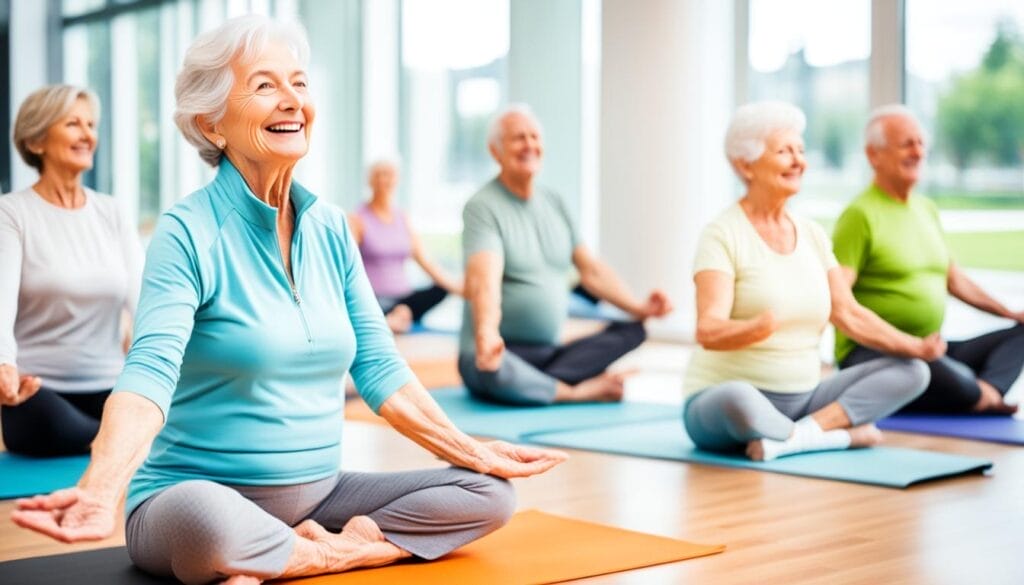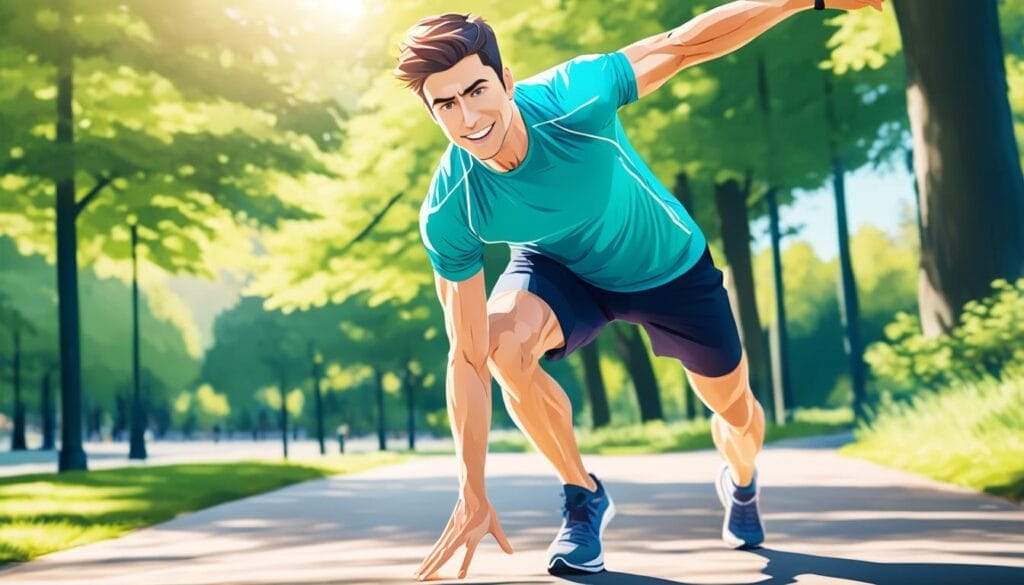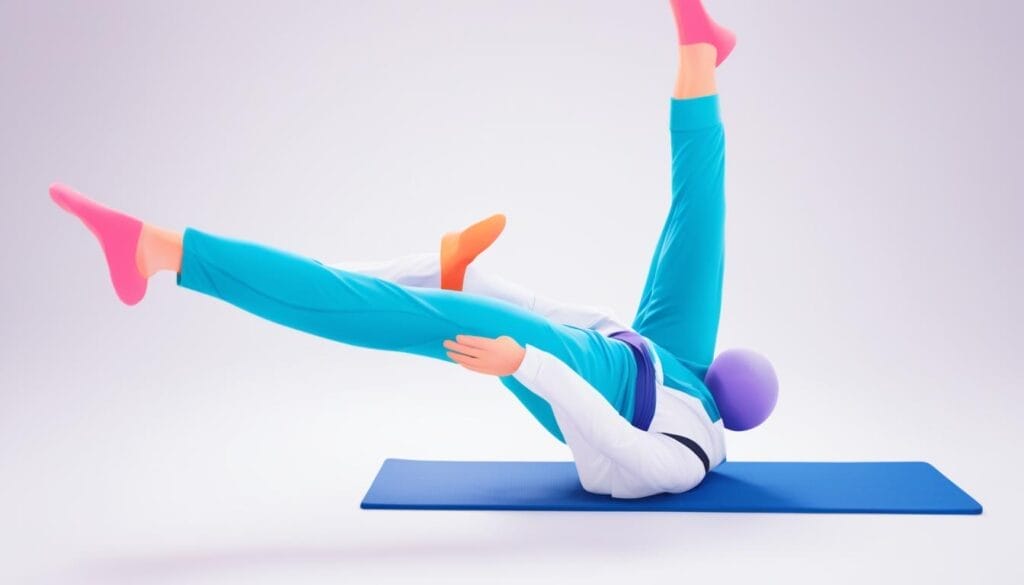Staring out of my window, I see time slip away. It seems like running and moving effortlessly was just yesterday. But now, in my later years, easy movements take more effort. This shows how much we forget to appreciate flexibility.
Being flexible isn’t only about touching your toes or doing splits. It means having the freedom to move fully. Flexibility for seniors is about reaching up for a book, playing with grandkids easily, and enjoying things that make us happy.
In this piece, we’ll dive into why flexibility is crucial for seniors. We will also share some handy advice on staying limber. After all, at any age, everyone should be free to live actively and fully.
Key Takeaways:
- Flexibility is vital for seniors to maintain physical mobility and independence.
- Regular stretching can improve posture, muscle coordination, and reduce the risk of injuries.
- Flexibility can be developed through exercise and consuming certain foods.
- There are different types of stretching exercises that seniors can incorporate into their fitness routines.
- By making stretching a part of our daily routine, seniors can enhance their overall quality of life and promote active aging.
Importance of Flexibility for Seniors
Staying flexible is vital for seniors. It helps keep their joints healthy and mobile. With age, flexibility naturally decreases. But, regular exercise can slow this process down. This includes specific flexibility exercises just for older adults.
Being flexible means seniors can move more comfortably. They find daily tasks easier, improving their life quality. It also lowers the chances of falls and getting hurt.
Stretching helps with balance too. It makes muscles work better together, which is key for not falling.
Flexibility exercises also make strength training easier for seniors. Better flexibility aids in stronger muscles. This is important for staying independent and managing daily activities.
So, keeping flexible is key to a senior’s health. It improves movement, lowers fall risks, and helps with strength exercises. Adding flexibility training to their routine can make a big difference in how they feel and move every day.
Stretching Tips for Seniors:
- Start with a gentle warm-up to prepare the muscles for stretching.
- Hold each stretch for 15-30 seconds, avoiding any bouncing or jerking movements.
- Breathe deeply and relax while stretching to maximize the benefits.
- Focus on major muscle groups, such as the neck, shoulders, arms, back, hips, and legs.
- Modify stretches as needed to accommodate any existing injuries or limitations.
- Perform stretching exercises regularly, ideally on a daily basis, to maintain flexibility.
It’s never late to work on your flexibility. With steady effort and the right direction, seniors can increase their range of motion. This helps in being more active and finding joy in life.
| Flexibility Exercise | Description |
|---|---|
| Neck Stretch | Slowly tilt your head forward, backward, and from side to side, holding each position for a few seconds. |
| Shoulder Stretch | Stretch one arm across your chest and hold it with the opposite hand, feeling the stretch in your shoulder. Repeat on the other side. |
| Seated Hamstring Stretch | Sit on the edge of a chair and extend one leg in front of you, placing your heel on the floor. Lean forward from your hips until you feel a gentle stretch in the back of your thigh. Repeat with the other leg. |
| Standing Calf Stretch | Stand with one foot slightly in front of the other and lean forward against a wall, keeping your back leg straight. You should feel a stretch in your calf muscle. Repeat with the other leg. |
Factors Affecting Flexibility in Seniors
Many things influence flexibility for seniors. These include things like your genes, how your body is made, whether you’re male or female, how old you are, how active you’ve been, and your injury or disability history. Each person’s flexibility is affected differently by these factors.
Getting older makes it harder to stay flexible. This is because our body naturally gets less stretchy and mobile. Muscles and tendons lose some of their stretch, soft tissues get drier, and joints become stiffer as we age.
But, there’s good news. Older adults can still get more flexible with the right exercises. Studies show that doing exercises to improve flexibility really works, even as we get older.
To keep flexible as we get older, focusing on our joints is key. Flexibility and joint health are closely linked. Being able to move our joints well is important for daily tasks and staying active.

Flexibility and Joint Health
For seniors, being flexible is important for strong, healthy joints. Flexible muscles around our joints help support us better, making us less likely to get hurt. This can reduce the chances of falls and long-term muscle or joint problems.
As flexibility decreases with age, it gets harder to move. This can really affect how well we can do daily activities and our happiness. Doing regular exercises to stay flexible helps. It can make moving easier and improve our quality of life.
| Factors Affecting Flexibility in Seniors | Solutions |
|---|---|
| Genetics | Regular flexibility training |
| Anatomical structure | Age-appropriate stretching exercises |
| Gender | Joint-strengthening activities |
| Age | Modified yoga or Pilates |
| Activity levels | Active lifestyle with regular movement |
| History of injury or disability | Consultation with a healthcare professional for tailored exercises |
The table shows that by working on the causes of flexibility issues, seniors can boost their movement and joint health. With the right exercises, older adults can stay flexible. This helps them stay active and live on their own for longer.
Different Types of Stretching for Seniors
Improving flexibility for seniors means looking at two main stretches: static and dynamic. Both kinds of stretching have their own special benefits. They should be part of a senior’s exercise plan.
Static Stretching
Static stretching means holding a pose for 15 to 30 seconds. You should do this after a warm-up to avoid getting hurt. It makes muscles longer and keeps them still, which makes you more flexible.
Seniors find this type of stretching very helpful. It eases tight muscles and makes them more flexible. Here are a few examples of static stretches:
- Hamstring stretch: Sit on a chair, one leg outstretched. Lean forward to touch the outstretched foot.
- Shoulder stretch: Stand tall. Put your hands behind your back. Gently lift your linked hands up.
- Tricep stretch: Put one arm above your head and bend it. Use your other hand to gently pull the elbow behind your head.
Dynamic Stretching
Dynamic stretching means moving your muscles and joints all the way. This kind of stretching is perfect just before you start your main exercises. It warms the body up and gets it ready to move.
It helps by making blood flow better, warming your muscles, and boosting how well you move. Seniors also find their balance and coordination get better with these stretches. Here’s what dynamic stretches look like:
- Arm circles: Stand with arms to the side, and circle them forward and back, slowly making the circles bigger.
- Knee lifts: Stand straight and lift each knee towards your chest one at a time. Focus on keeping your balance.
- Walking lunges: Step forward, bend your knees into a lunge. Then, pull your back leg forward and repeat with the other leg.
Both static and dynamic stretching are great for older people. Doing both helps with overall flexibility and movement. Always talk to a doctor or a fitness expert before starting any new exercises. This is to make sure they are safe and right for you.
Tips for Improving Flexibility in Seniors
Staying flexible is vital for seniors to stay active. Doing regular stretches can make a big difference. It improves your flexibility and makes life better. Here are some easy ways to stay limber:
- Make stretching a daily habit: Just take five minutes every day to stretch. This keeps your muscles loose and makes you more flexible over time.
- Include different activities: Mix up your routine with other activities too. Yoga, pilates, and swimming are great. So are dancing and going for walks. They all keep your body moving and flexible.
- Stay hydrated: Keeping up with your fluids is crucial for staying supple. Water helps your muscles work well and keeps your joints healthy. This, in turn, helps you stay flexible.
Always tune in to what your body tells you. Start gently and then go harder as you get more confident. If you have health worries, talk to your doctor first before adding new exercises to your routine.
“Regular stretching can greatly improve flexibility in seniors and help them maintain an active lifestyle.” – Yoga Instructor

Stay Supple, Stay Active
Adding stretches and activities to your day keeps you flexible. Remember, being flexible is not just about your body. It’s about staying active and happy too. So keep at it. Make stretching part of your daily plan. Then, feel the great effects of being more flexible.
Flexibility Tests for Seniors to Determine Range of Motion
As we get older, it’s vital to check our flexibility. This shows us how mobile we are now. Plus, it helps us know where we can improve. Let’s look at three easy tests for seniors to find their range of motion:
- Sit and Reach Test: It checks how flexible your hamstrings and lower back are. Sit on the floor with legs straight and feet on a wall. Try to touch your toes. See how far you can reach or if you touch.
- Tying Shoelaces Test: This one tests hip and lower back flexibility. Sit in a chair with feet flat. Try to tie a shoe with one leg over the other. Notice any trouble or pain.
- Scratch Your Back/Brush Your Hair Test: This checks your shoulder and upper body reach. Try to scratch your back or touch your shoulder blades with both hands. Watch for any tight feelings or hurt.
Doing these tests often helps you see your flexibility improvements. It’s smart to see a doctor before you dive into exercises. This makes sure you stay safe and actually get healthier.

Adding these tests to your workouts gives you clues on your flexibility. Always pay attention to how your body feels. This way, you dodge getting hurt. With these checks and doing the right stretches, you’ll stay mobile and enjoy life as a senior.
Summing Up Flexibility
Being flexible is key for seniors who want to keep healthy and active. It helps with posture, how well you move, and how your muscles work together. This means less chance of feeling stiff and fewer injuries. Stretching often and doing activities that keep you moving can make a big difference.
It’s really important to keep at it regularly. Stretching every day and being in tune with your body helps avoid getting hurt. Adding stretching to your day not only boosts your quality of life but also makes growing older actively more fun.
Seniors should try new things like yoga, pilates, being in the water, dancing, and walking. These not only help your body but also keep your mind sharp, let you connect with others, and bring joy. With regular effort, flexibility and health can stay strong. This way, seniors stay active and enjoy life to the fullest.
FAQ
How does flexibility benefit seniors?
Flexibility does a lot for seniors. It makes their posture better and helps them move easier. It also keeps their muscles working together well. This means they’re less likely to feel sore or get hurt.
Being flexible means their joints can move like they should. This supports them when they try to get stronger. And, it helps lower the chance of falling over.
Can flexibility be improved in seniors through exercise?
Absolutely, yes. Doing regular exercises can make seniors more flexible. Stretching is key. But, yoga, pilates, swimming, dancing, and going for walks can also boost flexibility.
What factors affect flexibility in seniors?
Many things affect how flexible seniors are. This includes their genes, body shape, gender, how old they are, and how much they move. Injuries in the past and any disabilities also matter.
Getting older naturally makes people less flexible. This is because their muscles and tendons become less elastic. Their soft tissues and joints also become stiffer.
What are the different types of stretching for seniors?
Two main stretching types are good for seniors. First is static stretching, where you hold a move for 15-30 seconds. Second is dynamic stretching, which keeps your body moving in a full range of motion.
Both types are helpful. Seniors should add them to their daily routines to stay flexible.
How can seniors improve flexibility?
To improve flexibility, seniors should stretch every day. Just five minutes can make a big difference over time. Plus, activities like yoga, pilates, and dancing keep them moving and flexible.
How can seniors assess their flexibility?
There are simple tests seniors can do to check their flexibility. These include the sit and reach, tying shoelaces, and scratch your back tests. These tests show seniors how flexible they are and what they can work on.
Why is flexibility important for active ageing?
Being flexible is key for seniors who want to stay active. It stops them from getting too stiff or feeling pain. It also makes everyday movements easier. Flexibility helps seniors live a better life.
Source Links
Share Me:
READY TO UNLEASH
YOUR BEST SELF?
Click “Sign Me Up!” And Start Your Fitness Transformation!





